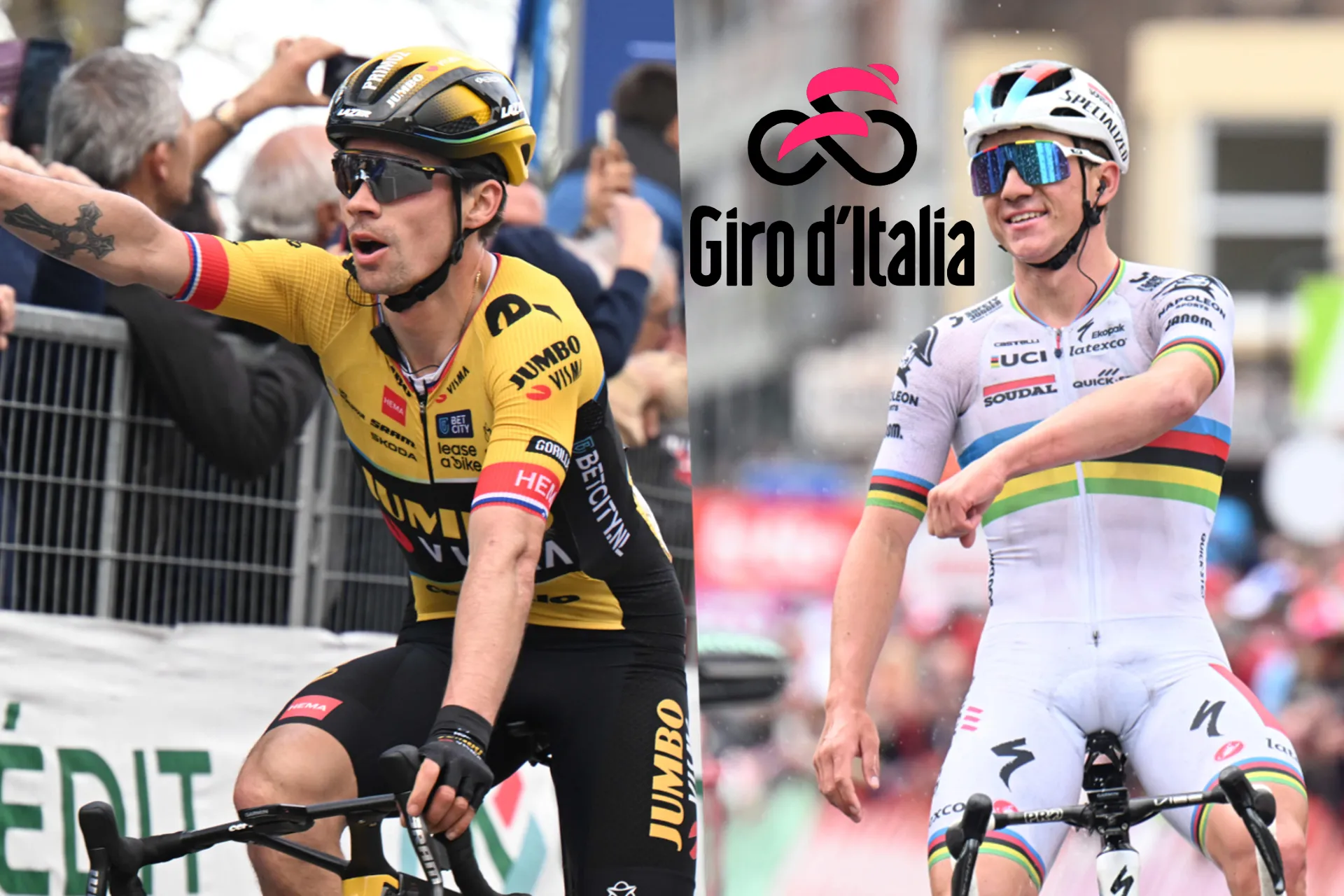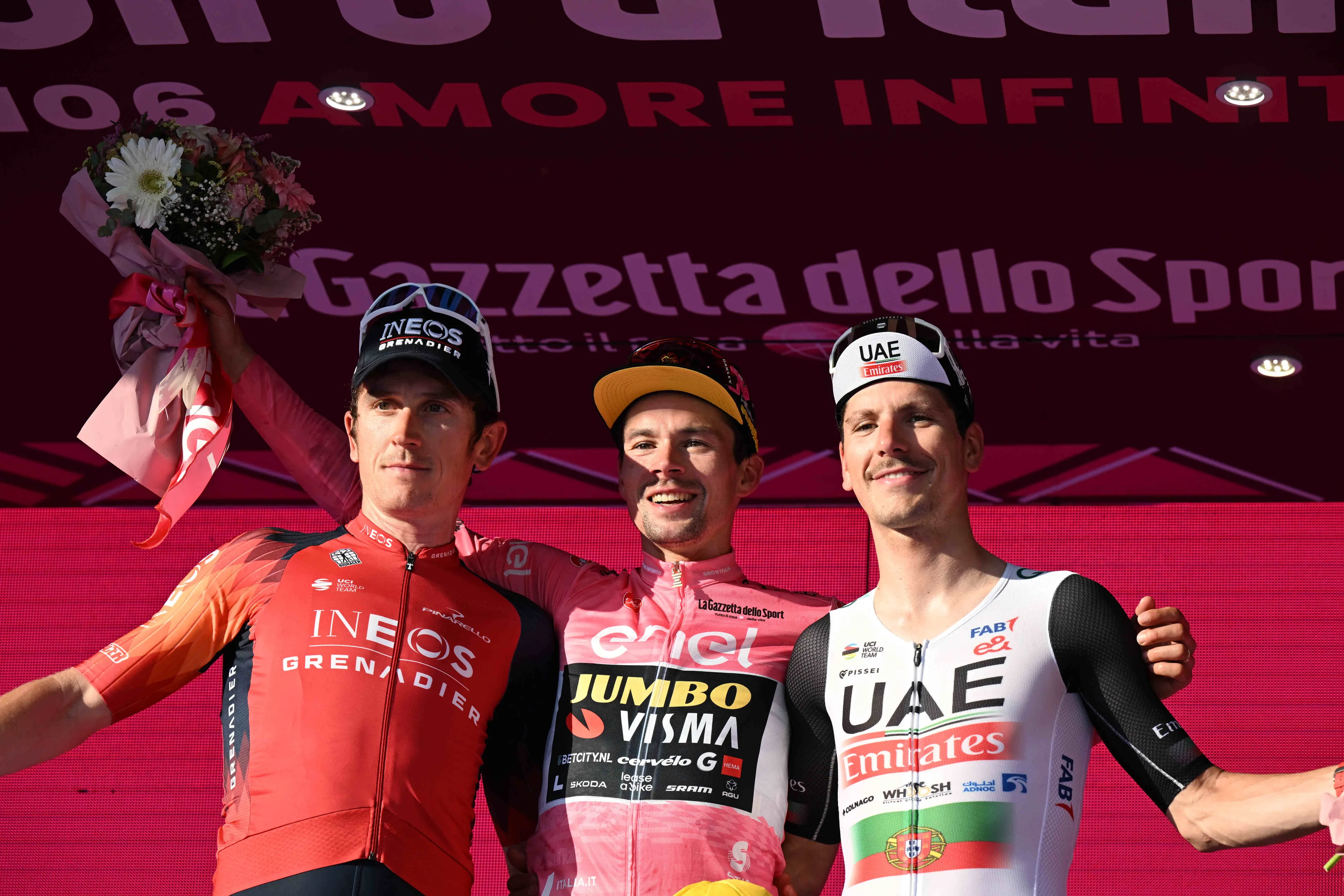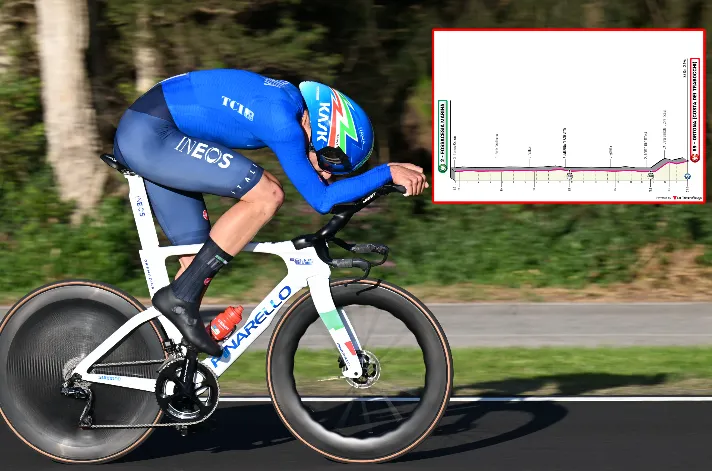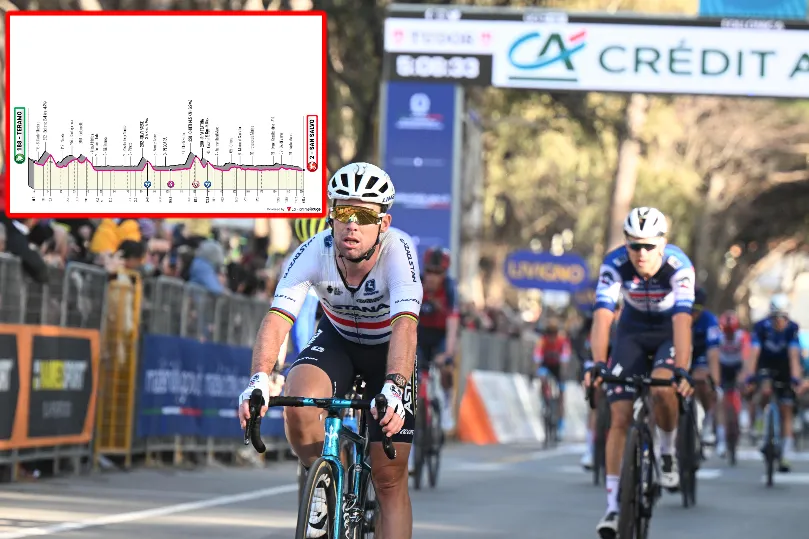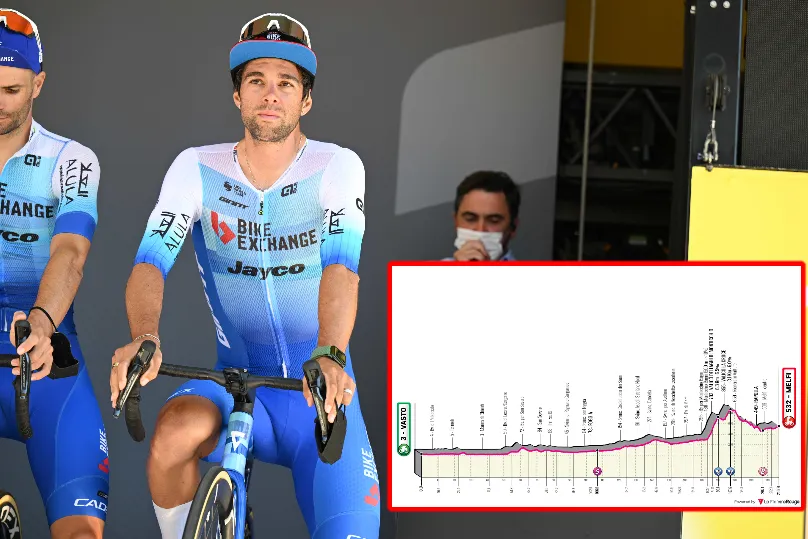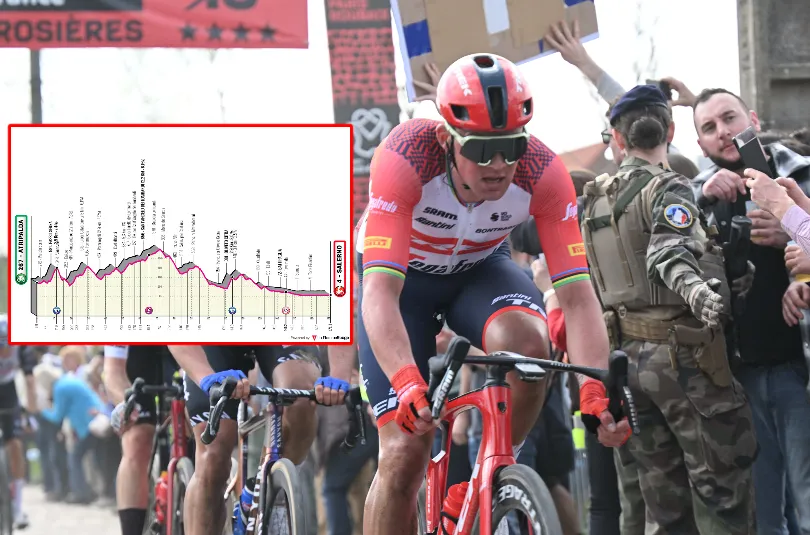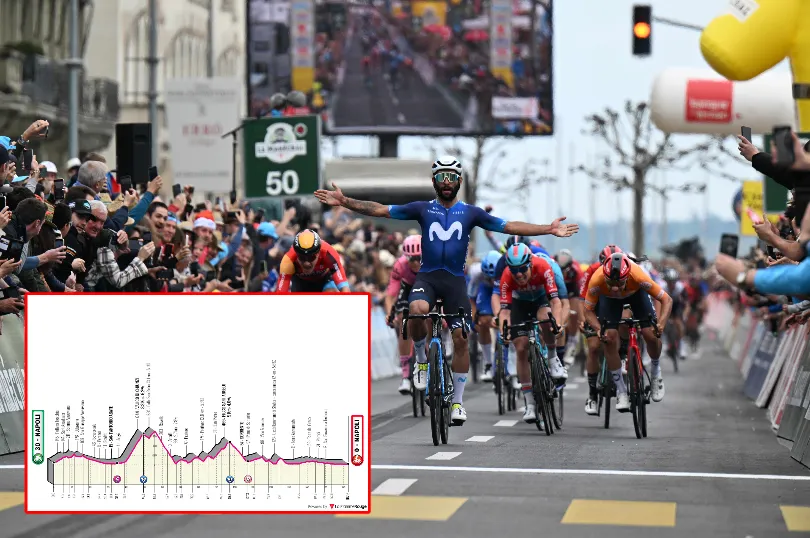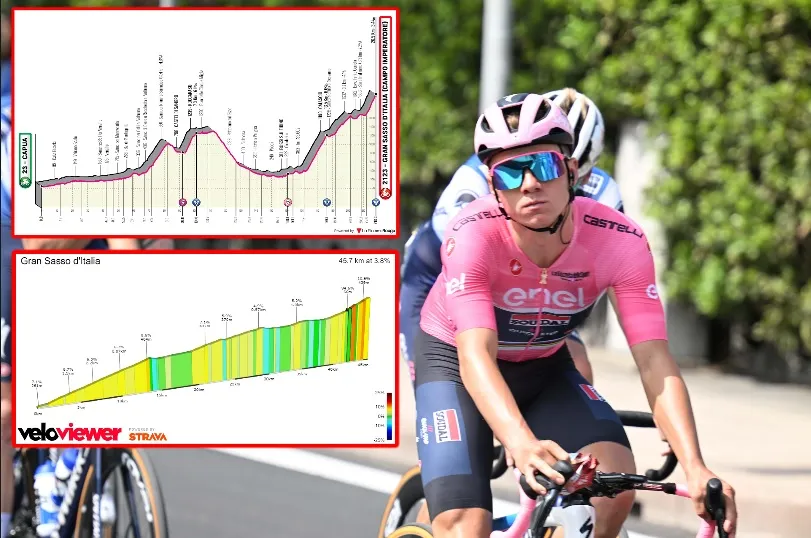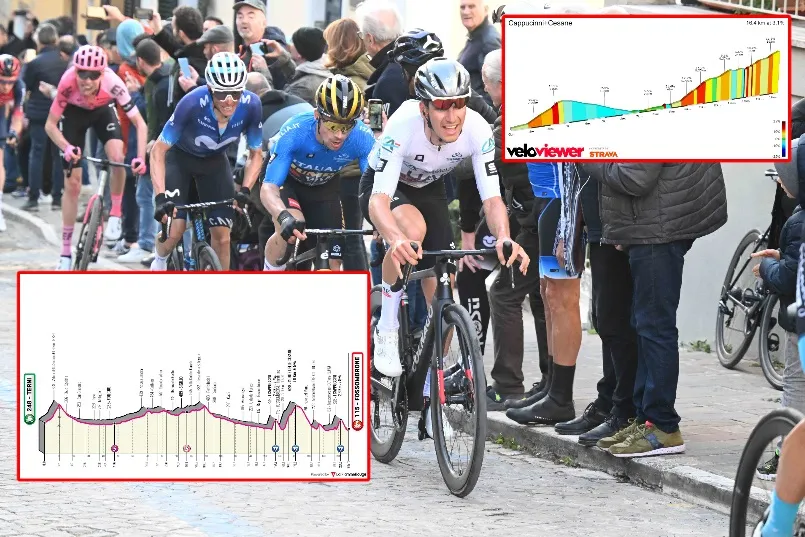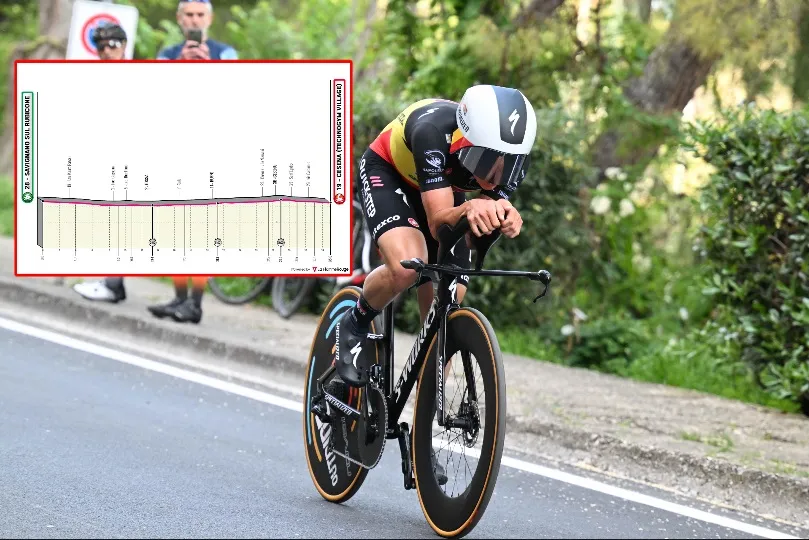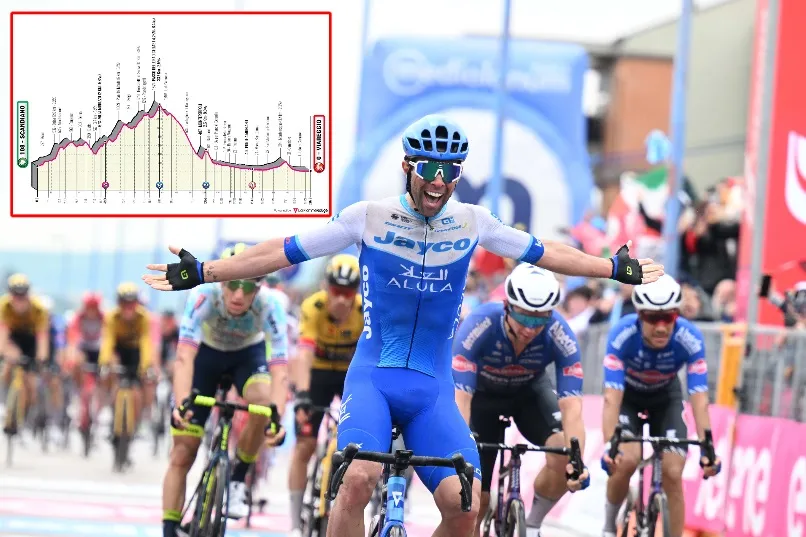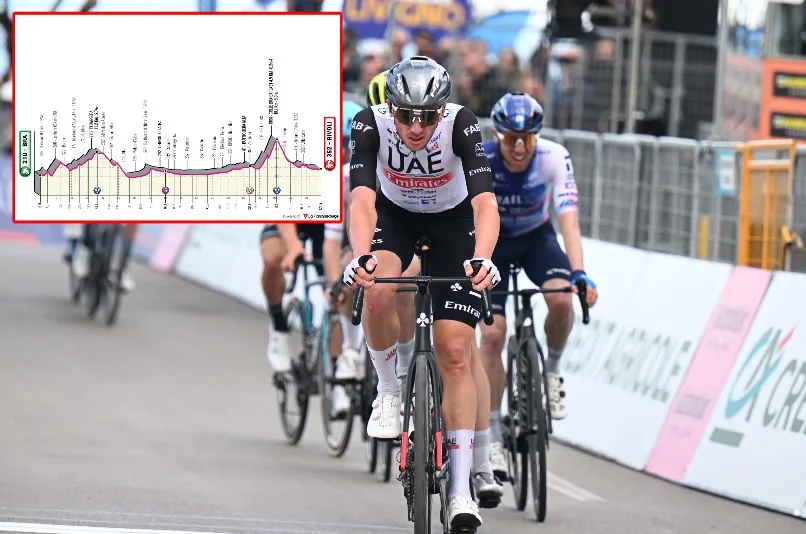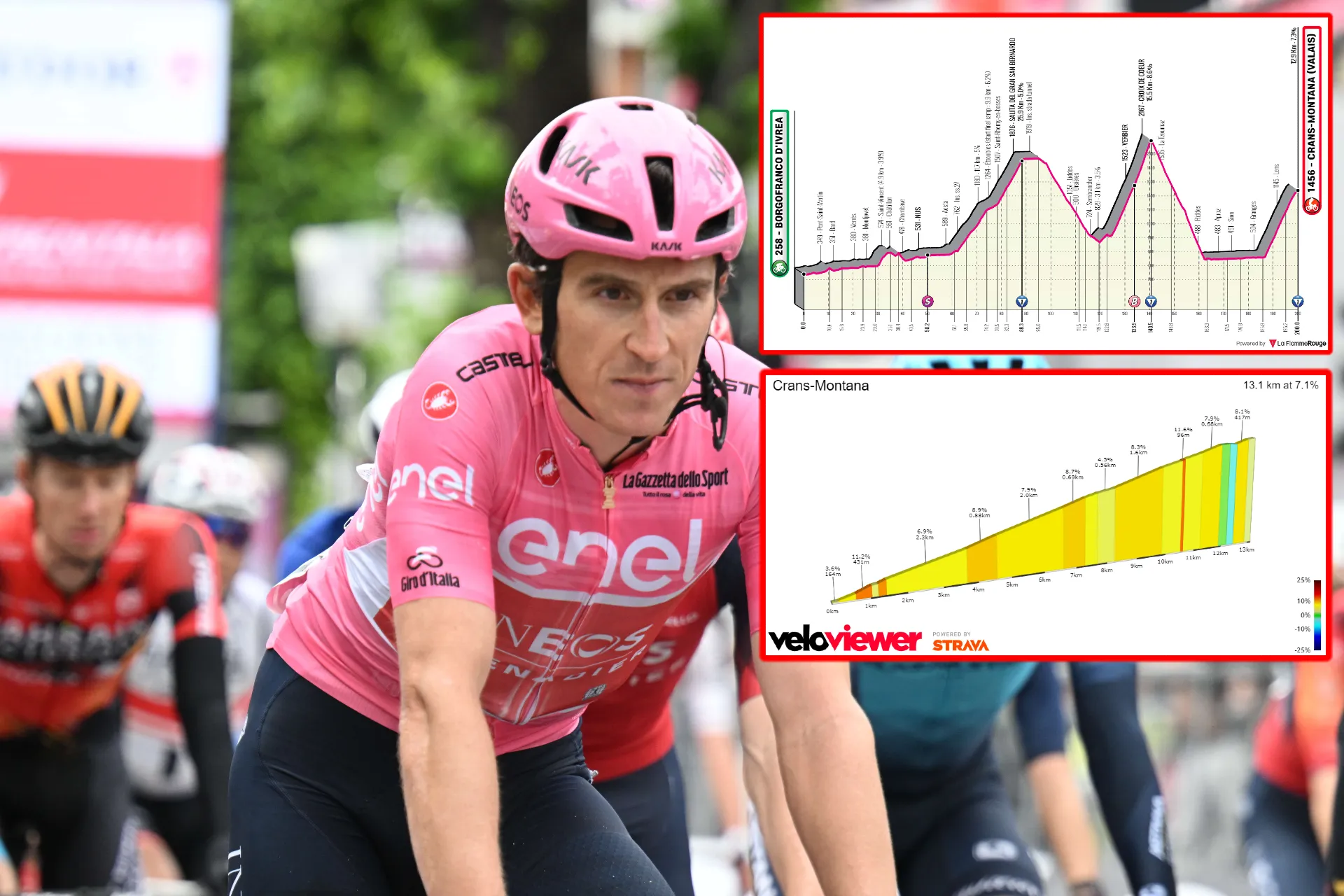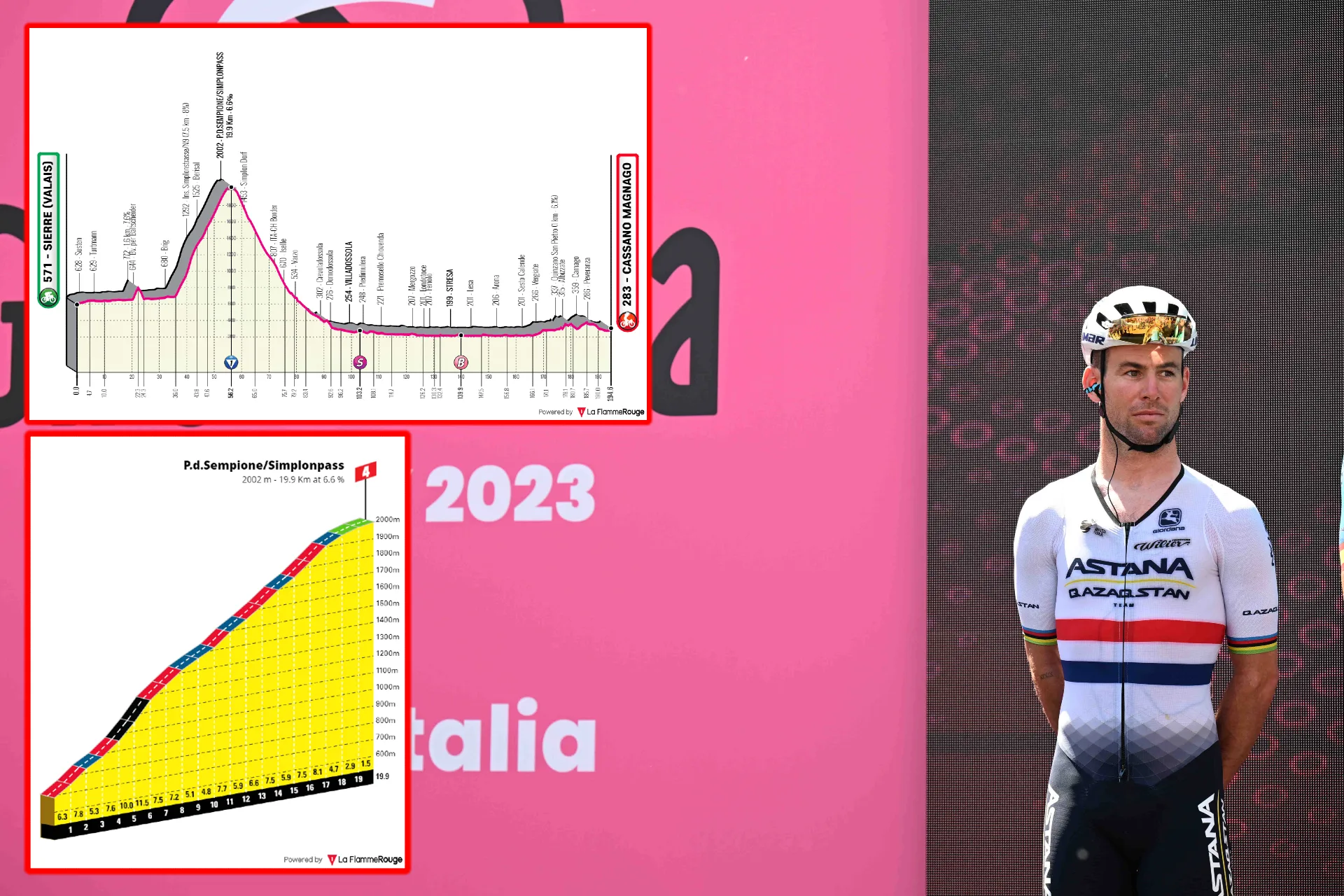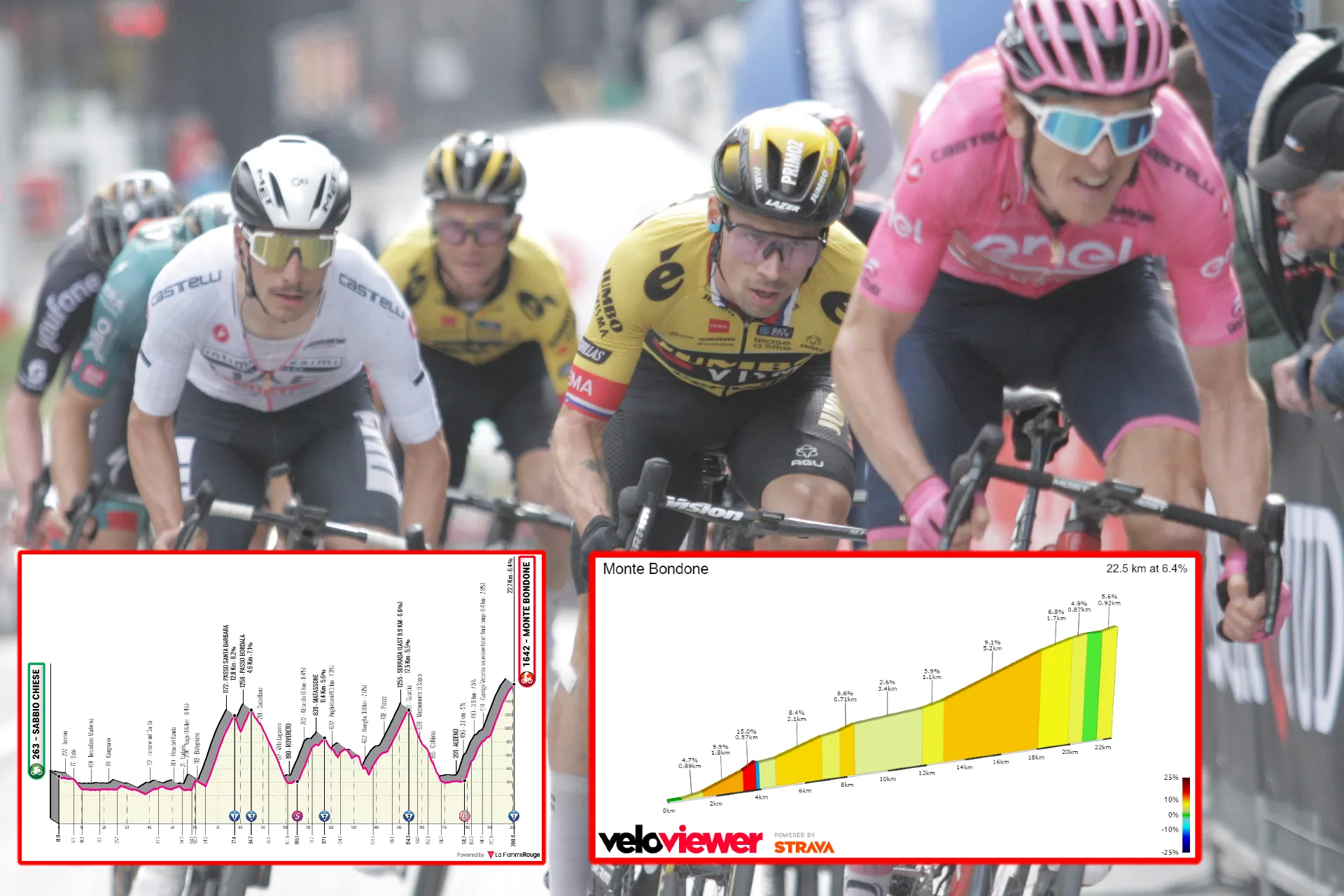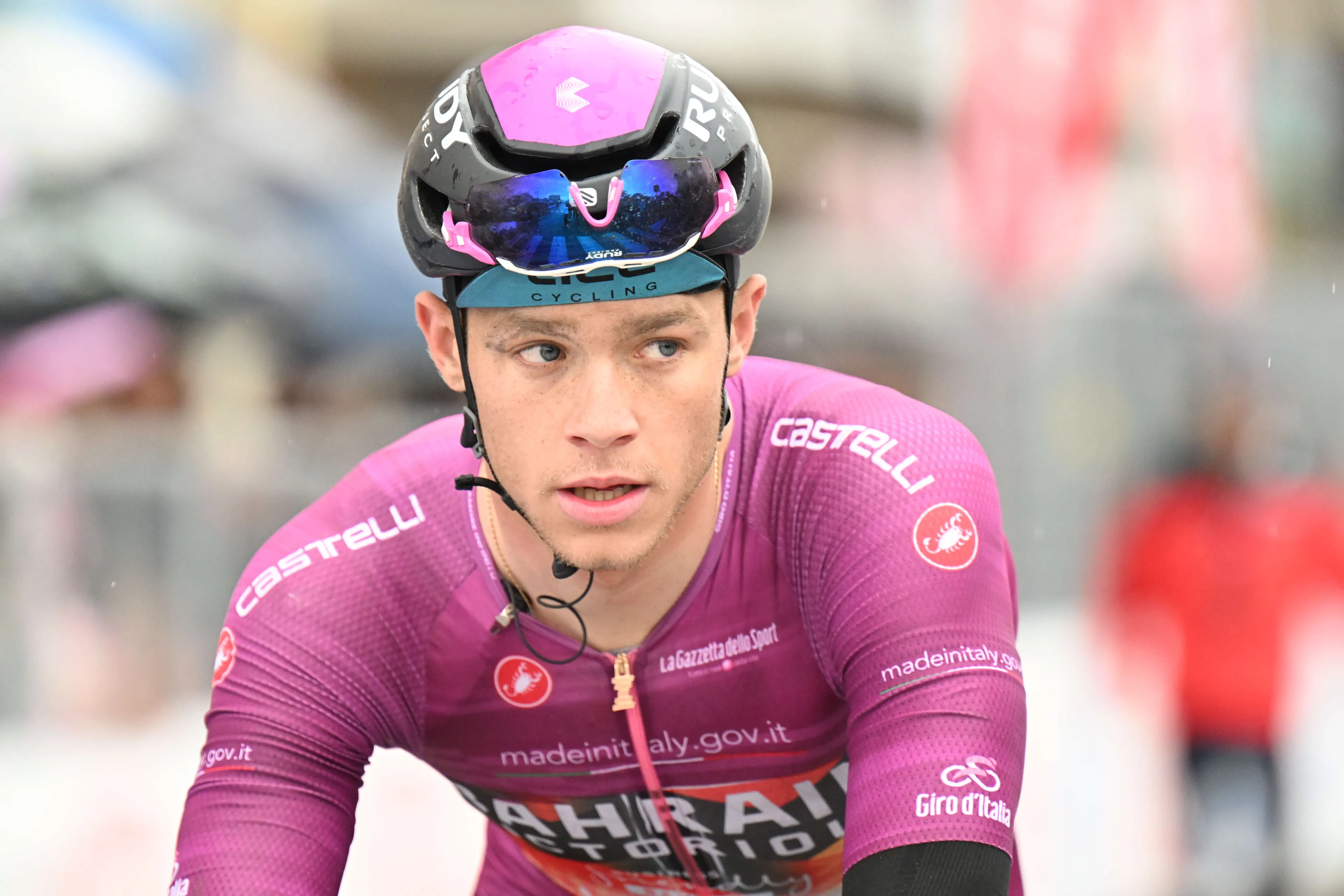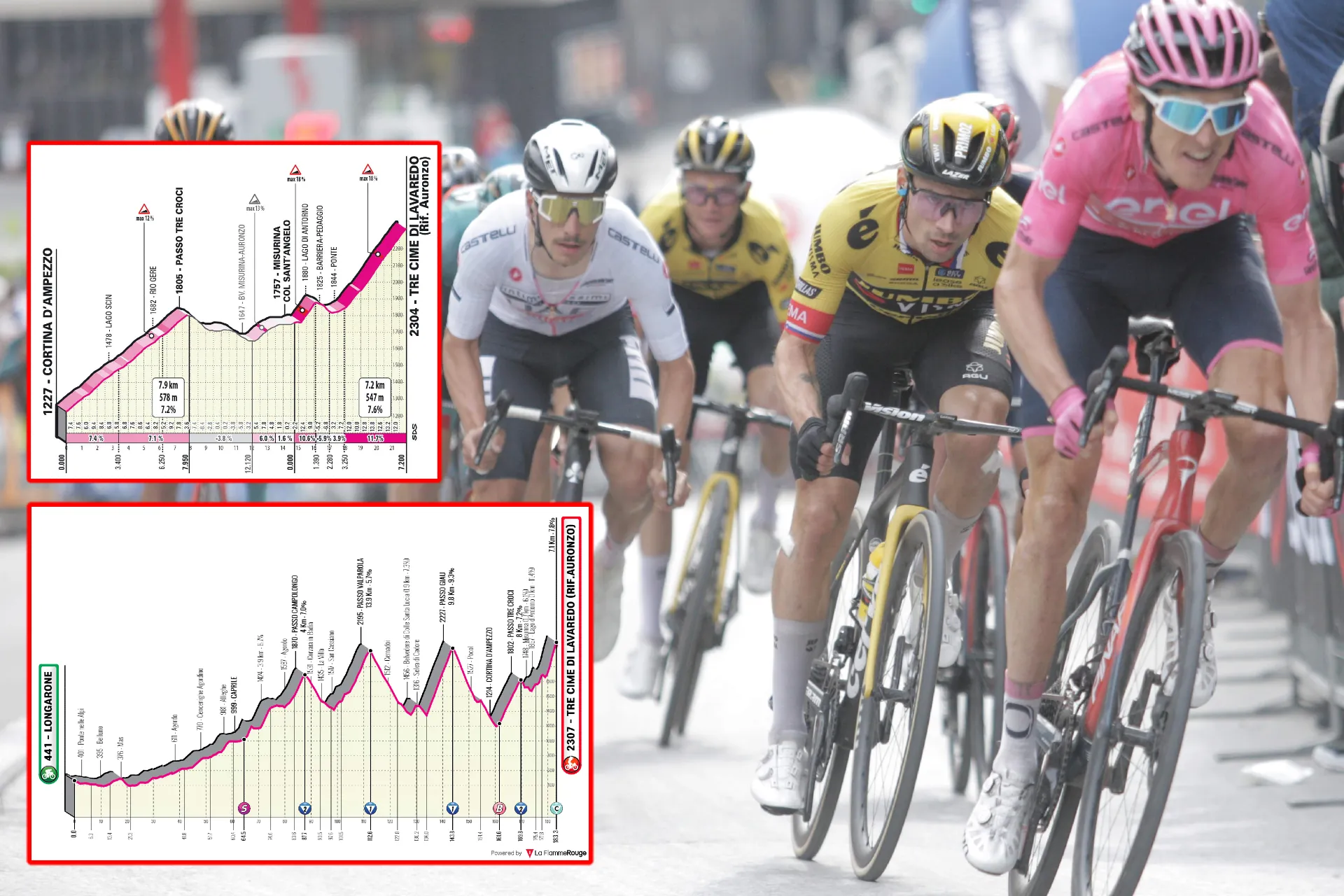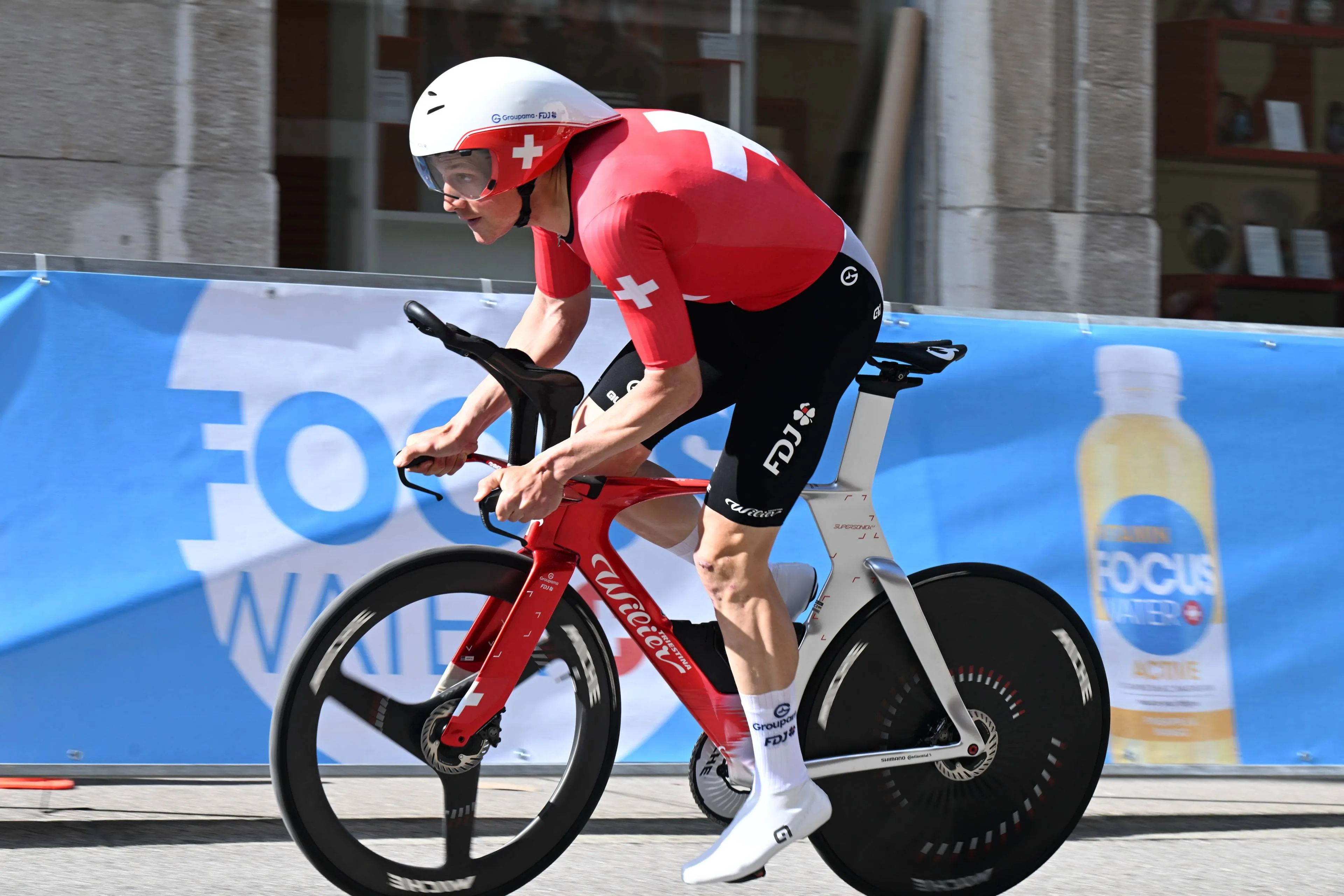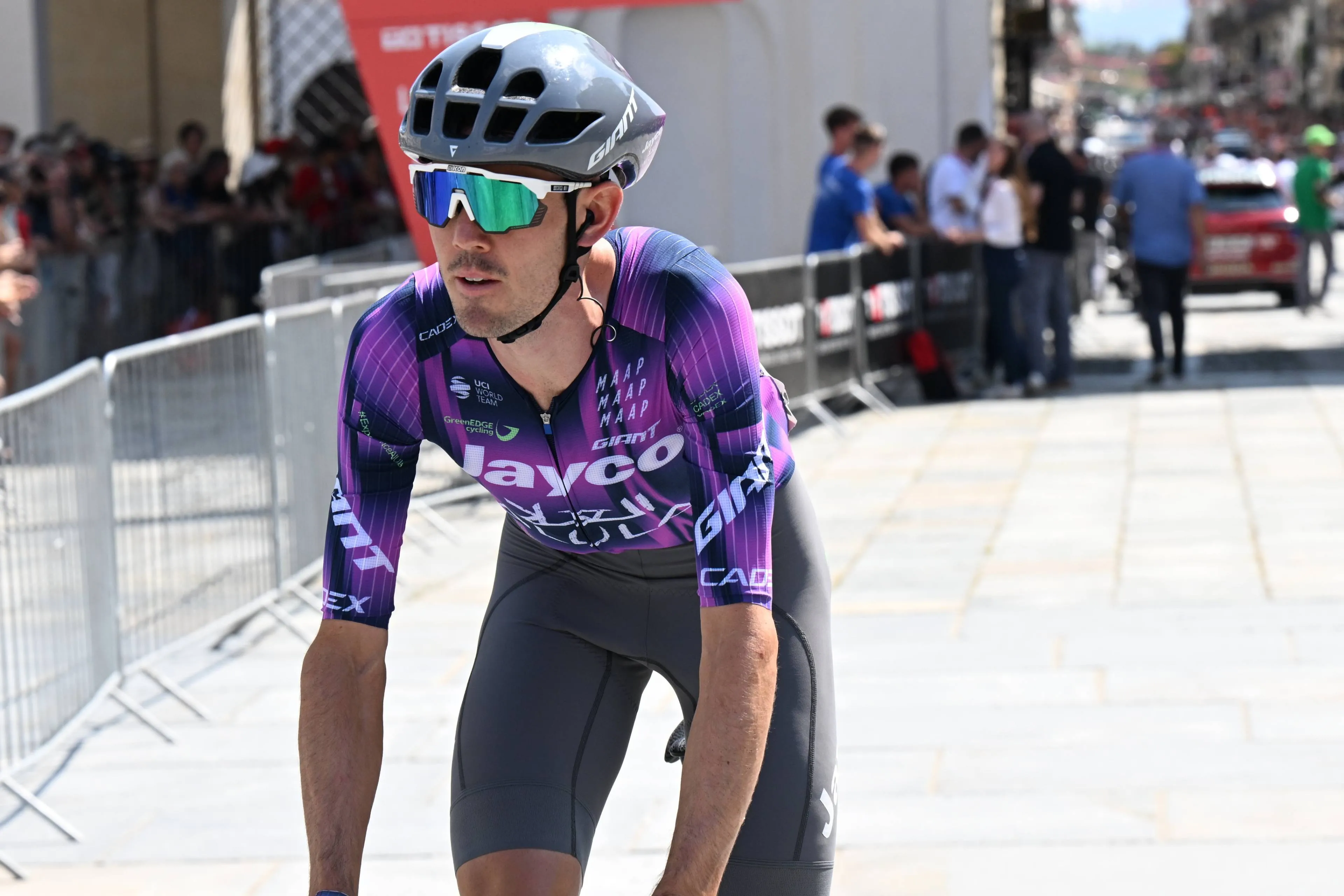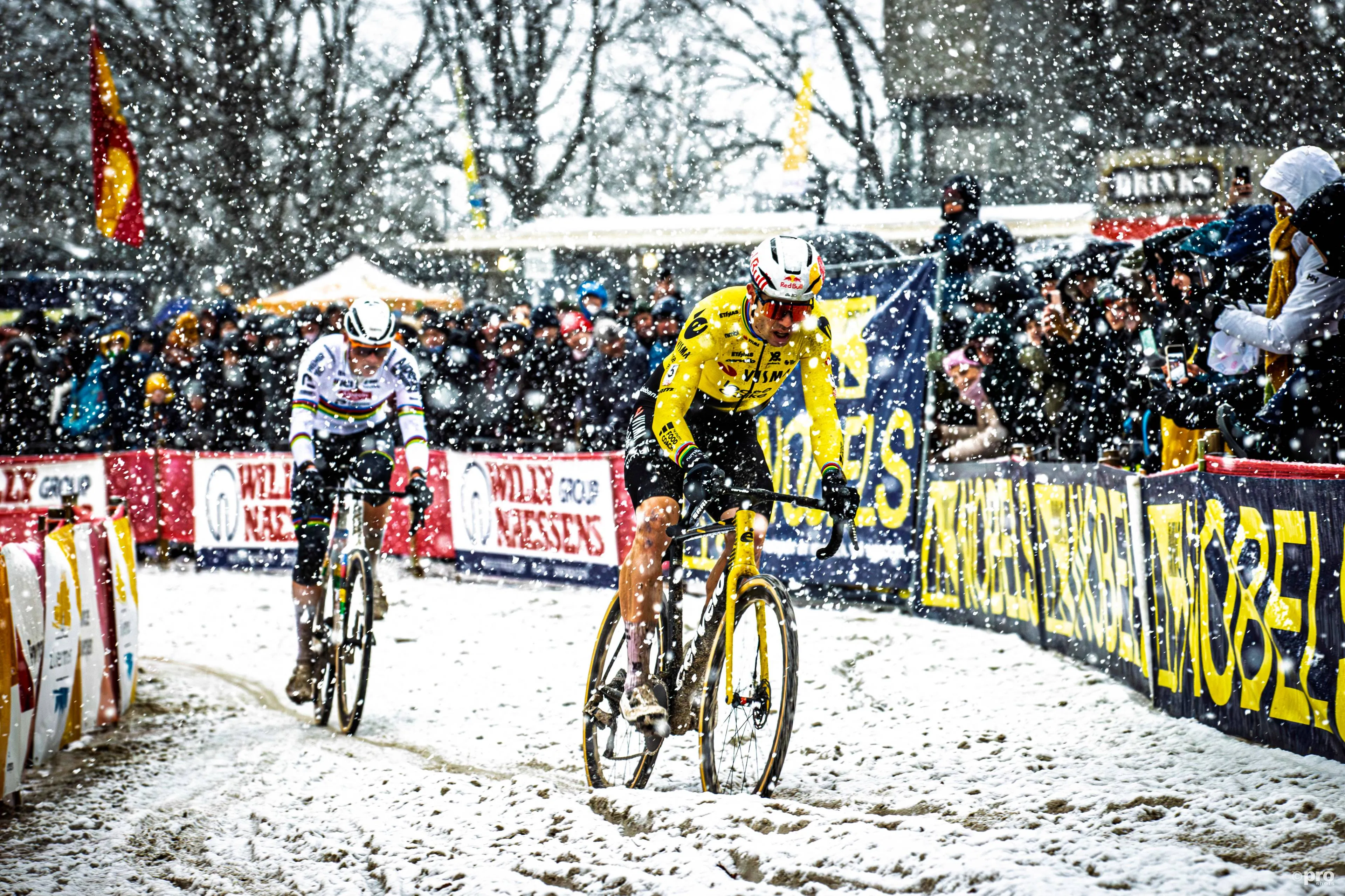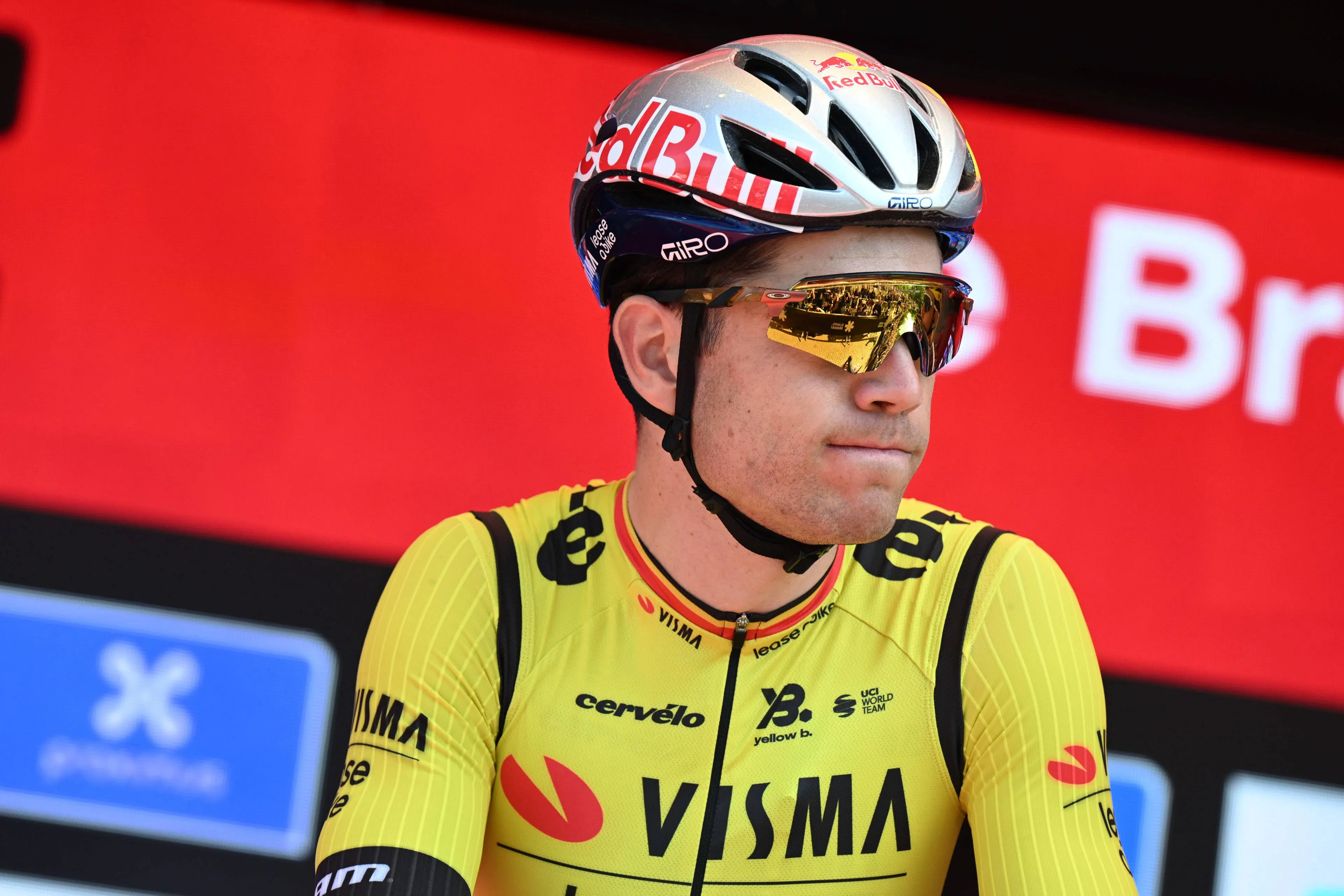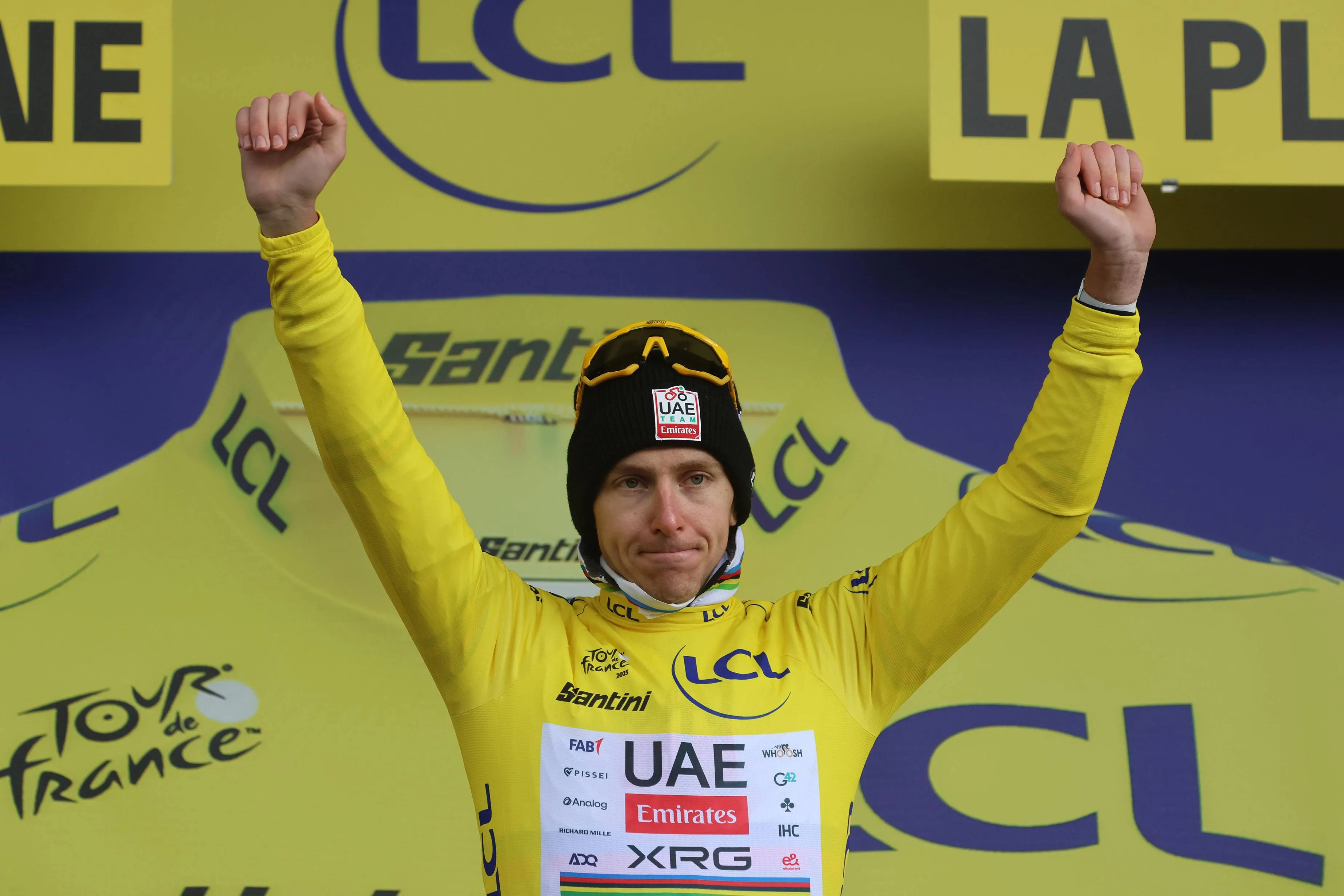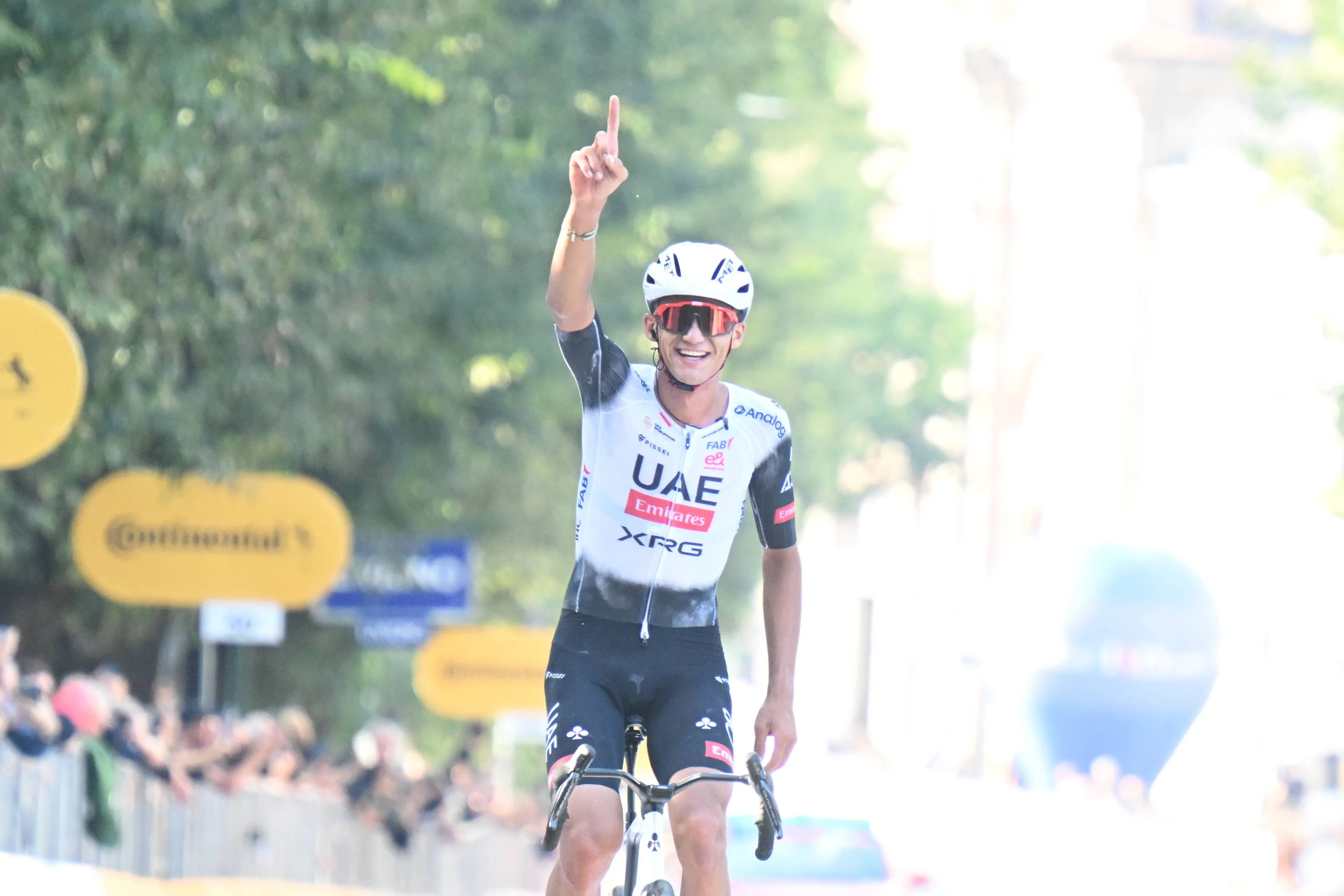
Profiles. The 2023 Giro d'Italia route has finally been announced! The race will feature several very tough high-mountain stages, as well as a lot of time-trialing kilometers which will make for a very balanced race throughout three weeks from the 6th to the 28th of May.
It is a brutal route with several mountaintop finishes, many hilly stages packed with climbing that will disrupt the possibility of sprints, three different individual time-trials and few opportunities for the true sprinters. It will be a thrilling edition of the race surely, and you can find the details of it below.
Click
here to create
your own team for the Fantasy Giro d'Italia. At least 21,875 USD/20,000
Euro/17,615 GBP in prizes!
Read also
Stage 1 (ITT): Fossacesia Marina - Ortona, 19.9Km
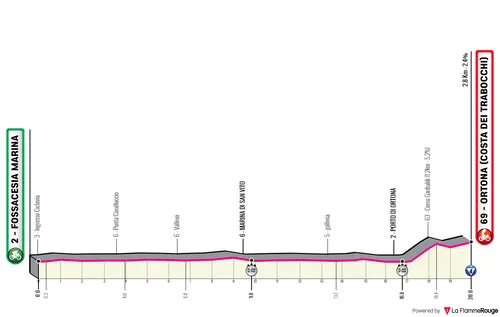
The Giro d'Italia will start with an individual time-trial from Fossacesia Marina to Ortona, across 19.9 kilometers that will set early gaps for the overall classification, and hand out the first pink jersey. It is an important day. Although in the big picture the differences will be small, in 20 kilometers there is without a doubt ground for the specialists to take a minute or over on those that will struggle against the clock, and most importantly it will already dictate order into the first mountain stage.
Read also
The stage is 19.9 kilometers in total, most of them flat and straightforward by the Adriatic sea. It's almost completely an effort for the purists, however nowadays the top time-trialists can also climb these types of hilltops with the best. The effort ends in the top of the town of Ortona where there will be a small ascent into the finish.
It will make no difference in bike choice, there is a 1.2 kilometers ascent at 5.2% which is the main one. There are quite a few switchbacks in these final kilometers, the effort ends with a slight uphill drag to the line.
Read also
Stage 2: Teramo - San Salvo, 203 kilometers
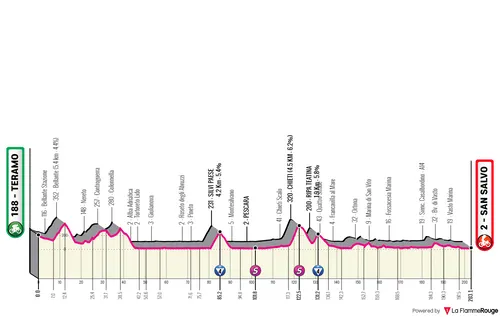
The second stage of Giro d'Italia will see the race have it's first bunch sprint, in Abbruzo, where the town of San Salvo will host the finale after 203 kilometers. It's a day for the sprinters, here the fight for the maglia ciclamino will start. It will be an interesting day where the Giro peloton will face each other for the first time, and it will also see a very tense finale as all GC riders will be hoping not to lose time.
The start of the stage will be rather hilly, but this stage isn't very viable for a breakaway. There will be three small hilltops where the escaping group should go up the road before reaching the sea. Three more small ascents will follow throughout the day but all are within the first two thirds of the day. There will be 72 kilometers to the finish after the final ascent which will be categorized, possibly exposed to wind, and without any meaningful feature.
The finale in San Salvo will be a pure sprinter affair. At sea level the riders face no gradients at all, and most of the final kilometers are on a single road by the coast. The finish line will be in the San Salvo Marina area, the riders will go through a roundabout with 1.3 kilometers and then have a right-hander with 900 meters to go into the finishing straight. This one is still long enough to gain back positions, but there will be a fight for positioning into the roundabout for sure.
Read also
Stage 3: Vasto - Melfi, 213.8 kilometers.
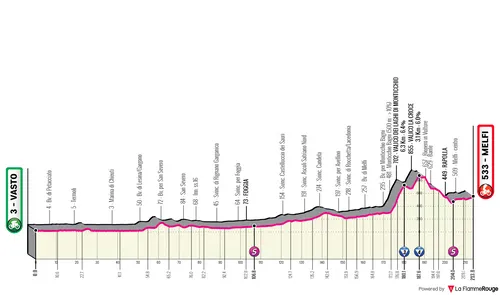
The third stage of the Giro d'Italia will see the race head south and include a few hills. It's a punchy stage with some climbing towards the end into Melfi, but should end in a reduced bunch sprint. Most of the day is in fact flat, it is very much a transition stage with 213 kilometers on the menu. The breakaway won't have an easy task to succeed as the first 175 will be fully hitting the wind with no descents to rest and no climbs to push on.
A draining day, but likely a calm one in the peloton. That is until the riders reach the two categorized climbs on the day. One is the Valico dei Laghi Di Monticchio which is 6.3 kilometers long at 6.4%. There is a very small flat section inbetween climbs, with the second half being the Valica La Croce which is an extra 3.1 kilometers at 6%. They finish with 33 and 26 kilometers to go respectively.
Read also
It is a traditional first-week Giro stage. It's a very open day where some sprinters who can climb should be the favourites, but it very much inspires late attacks. A lot can happen here, the descent isn't steep but it is technical, and until the very last kilometers the roads are anything but straight. It isn't easy to bring back attacks in this terrain.
Eventually the riders pass by the center of Melfi but the finale is outside of the center. They head into an explosive finish, the roads are rolling and the finishing straight sees a 4% gradient that is far from a pure sprint. Several roundabouts and corners, with 1.1 kilometers to go, 750 and 300 meters to go. The final corner is quite sharp, positioning is crucial and from that corner onwards it's a full-on sprint.
Read also
Stage 4: Venosa - Lago Laceno, 176 kilometers.
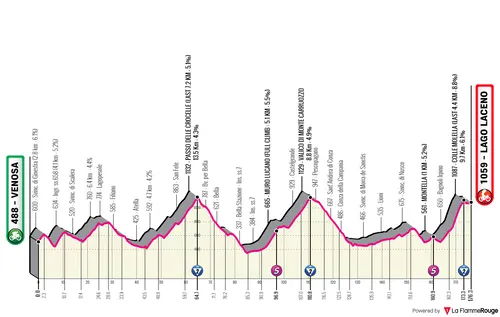
The fourth stage of the Giro d'Italia is set to end at Lago Laceno after climbing the Colle Mollela, as was the case in the 8th stage of the 2012 Giro d'Italia. After the individual time-trial, this should be the first stage to create differences between the overall classification contenders, featuring some tough gradients in the 10-kilometer climb.
The day features 3600 meters of climbing. It's not high-mountain but it's far from an easy day, and the total climbing amount may make it a more difficult and aggressive finale. The first mountain stage of the Giro is traditionally conservative and battled among the breakaway, and the tough start to the day favours those who want to make moves.
The day features two long categorized climbs in the middle of the day, one of them being 13.5 kilometers at 4.3% (112Km to go) and Valico di Monte Carruozo which is split into two, a 19-kilometer effort where with the exception of a flat section in the middle is mostly raced at 5% with . The roads will not be completely flat then until the final ascent, featuring small climbs and descents until reaching the town of Montella where the riders find an intermediate sprint and then move into the final climb.
This is the Colle Molella. In total it's 9.8 kilometers long at 5.9%, however it's also a climb of two halves. The first less steep and there is a section where riders can rest a bit. The second half is considerably tougher, with 4.4 kilometers at 8.8% towards the summit. Gradients of 10% will frequently be found, it is definitely hard enough to see attacks. The summit is only 3 kilometers from the finish. The final kilometers then are flat and without corners, ideal for late attacks to spring off for the win if a modestly sized group is at the head of the race.
Read also
Stage 5: Atripalda - Salerno, 171.2 kilometers.
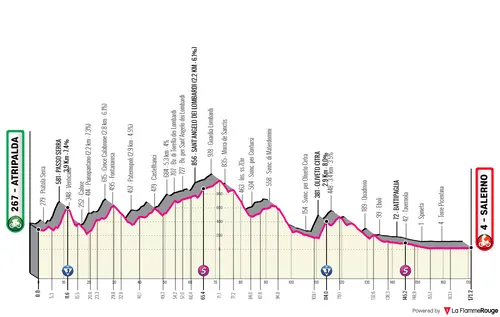
The 5th stage of the Giro d'Italia should be a day for the sprinters, or perhaps one suited to the breakaway as a hilly day, with the start and finish taking place in Atripalda and Salerno specifically. What exactly will happen is hard to predict nd depends on the breakaway of the day, there is a total of 2500 meters of climbing in the 171 kilometers and they are almost exclusively in the first two thirds of the stage.
Certainly the sprinter teams will want to thoroughly control the start of the stage, and carry a pace that never allows the gap to grow much. That won't be easy however, there is a 3.9 kilometers ascent at over 7% in the opening kilometers of the day. However the situation doesn't get easier throughout, with several small ascents and a few descents, but no true flat roads where riders can relax.
With 57 kilometers to go the riders end their final categorized climb of the day, it is almost 3 kilometers long at 8%, it's in no way an easy climb and one where if the pace is pushed gaps can appear, sprinters can be put under serious difficulties. There is another small hilltop right after the summit, it's not terrain where those dropped can easily return to the peloton, with just over an hour of racing remaining the pace will also certainly be high.
The riders reach 448 meters of altitude at the end of that hilltop, and then, without any major descent, come down to sea level with the finish line at only 4 meters of altitude. This is a clear sign that the speed will be quite high in approach to the finish.
The riders reach the Tirreno sea coast however and the final 15 kilometers will be pan-flat and by the sea. Exposed, fast, but should see a bunch sprint decide the outcome. The riders head into Salerno and there will be no obstacles. The riders follow the same road all the way into the finish near the city center, there is nothing relevant to mention regarding this sprint, it is as "simple" as it looks on profile.
Read also
Stage 6: Napoli - Napoli, 162.6 kilometers.
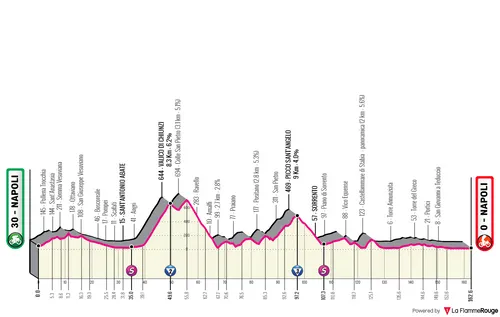
After it's 2022 success where Thomas de Gendt, Mathieu van der Poel and Biniam Girmay protagonized an explosive breakaway stage, Napoli is set to host another stage at the Giro d'Italia. It won't feature the same local circuit however, and is expected to be a day for the fast men - although breakaways could very well succeed aswell.
The day is far from flat. The sprinters could have their opportunity but they must work for it. The climb to Valico di Chiunzi opens things up, it's 8.3 kilometers at 6.2%. It's far from the finish but sees another hilltop and technical descent right after. The riders then ride through the Amalfi Coast, familiar to fans likely for other reasons, but here some riders may suffer. The roads are not flat, and even passing by the small towns the riders will need to be climbing.
The riders leave the coast and begin to climb towards the summit of Picco Sant'Angelo, which summits with 65 kilometers to go. It's 9 kilometers at 4% and the descent into Sorrento is very technical, directly into the intermediate sprint. There will be another hilltop with 37 kilometers to go, 2 kilometers at 5.6%, but the rest of the approach to the line is flat.
The riders fly through the center of Napoli, they will race close to the coast the whole way into the finish line in what will be a nervous finale. There will be corner with 2.4 and 2.2 kilometers that will stretch things out, and another with 1.7 kilometers which will be tricky. Just outside the final kilometer there will be a slight chicane but the finale is then very fast and uninterrupted.
Read also
Stage 7: Capua - Gran Sasso d'Italia (Campo Imperatore), 218.2 kilometers.
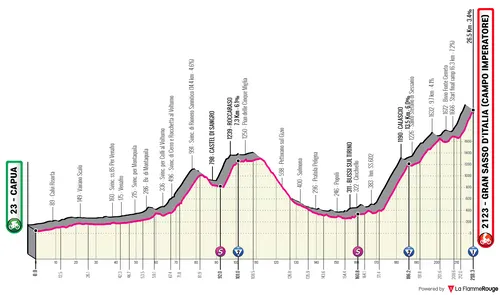
Stage 7 will be a long day on the road with the start in Capua, with a summit finish at over 2000 meters which will make for the first high mountain stage within the Apennines. It's the first true high-mountain stage and perhaps features the longest summit finish of the high-level calendar. Gran Sasso d'Italia hosts a finale at the Giro once again, with the finish line at Campo Imperatore.
The first 70 kilometers will mostly be flat, but from there on the scenario changes. Two ascents consecutively follow, one with 14.4 kilometers at 4.6% and into Roccaraso they'll climb 7.3 kilometers at 6.1%. This ends with 117 kilometers to go, this is a particularly long day on the bike, featuring several climbs but also a whole 218 kilometers in distance. It'll be a test of endurance, which will be made harder by the finale that follows.
The Apennines hold some jewels and this is one of them. 45 kilometers of climbing. They aren't without a few sections of restbite but there are only two section that feature tiny descents of a few meters. The riders will climb 1800 meters of altitude into a summit finish at over 2100. The start of it will be tough with the peloton facing the climb to Calascio which is 13.5 kilometers at 6%. There will be another 9.7 kilometers at 4% after, but these will be preparation for the actual final ascent.
Into Campo Imperatore the fatigue will start to feel itself, it's 6.3 kilometers at 7.2% and the gradients go up to 10% towards the end. It's an interesting summit finish, definitely one where differences can be made. Certainly the GC riders will save their legs for the final steep bits but there is the chance that such a long effort will completely drain the legs of some before the attacks come.
Read also
Stage 8: Terni - Fossombrone, 207.1 kilometers
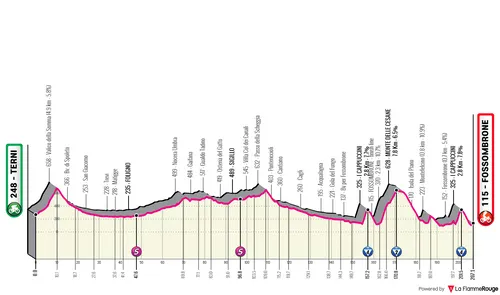
The eighth stage of the Giro d'Italia should be a hilly and explosive one into Fossombrone. The double ascent of Il Capuccini a climb of around 2 kilometers at 10%, will be the main feature of the day, which could see the GC fight implode once again. This finale was seen in the 4th stage of the 2019 Tirreno-Adriatico where Alexey Lutsenko took the win. This could easily become a day for the GC riders, despite it's proximity to a decisive day.
Early in the day the riders find a 4.9-kilometer climb at 5.8% which should be a launchpad for a breakaway to be formed. This could be crucial in the outcome of the day. Many of the kilometers that follow are flat and will be rather calm. That will change however in the run-up to I Cappuccini. The first time up the climbs ends with 50 kilometers to go, but the focus lies afterwards, with a technical descent and a steep ramps once again right after.
Monte delle Cesane is 7.8 kilometers at 6.5%, but the first 2 are at over 10%. Another explosive climb. It soothens out towards the finish but is nevertheless a difficult one, ending with 37 kilometers to go. The descent will be nervous afterwards, and right after another steep ramp at Montefelcino, which is 800 meters at 11% summiting with 20 kilometers to go.
If everything goes normal however the race is to be decided on the final ascent. The riders go into I Cappuccini once again but this time around everyone will likely go to the very maximum. The summit comes only with just over 5 kilometers to go, the ascent is 2.8 kilometers at 7.8% but that is because of a gentle start which is considered part of the climb. In fact it's around 1.5Km at well over 10%, with the steepest ramps reaching 19% close to the summit. A brutal one. It's a small descent but a technical one. The riders will reach the finish very quickly, a few sketchy corners will require the riders to control the adrenaline, and the final two kilometers then are flat.
Read also
Stage 9 (ITT): Savignano sul Rubicone - Cesena, 35 kilometers.
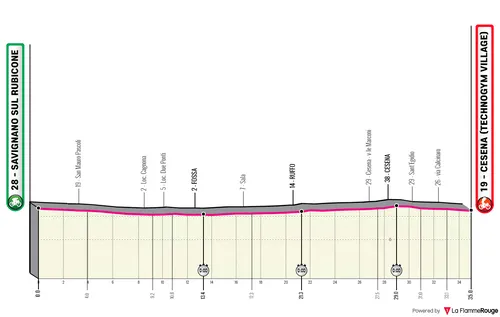
2023 will be an edition favourable to the time-trialists. The 9th stage of the Giro d'Italia is certain to be a time-trial with a distance of 35 kilometers. Savignano sul Rubicone and Cesena host the start and finish of what is an important day for the overall classification.
There is a hilly, a mountainous and a flat time-trial. This one is the latter, but also the longest. The roads will be completely flat from start to finish however not perfectly straightforward. There are a few tricky corners throughout the course however as long as riders take precaution crashes shouldn't be a risk.
It's a day to make time, the specialists can easily take something like two minutes on the more modest competition. It's perhaps the most important day of the opening week, where gaps will further be cemented.
Read also
Stage 10: Scandiano - Viareggio, 196.8 kilometers.
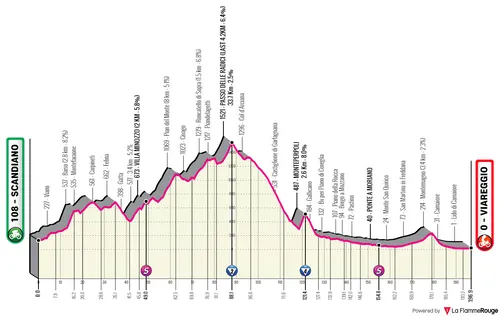
The tenth stage of the Giro d'Italia will see a relatively hilly day from Scandiano to Viareggio which will take the riders close to the Tirreno sea, one that will be very tricky to predict as the first half is very rolling whilst the second is almost pan-flat. A difficult day to predict, 3000 meters of climbing make it just a little too complicated to control for some of the sprinter teams, it'll be an interesting one.
The start of the day sees some uphill drags, however a 2.8 kilometer climb at 8.2% with only 15 kilometers of racing sees a spot where it'll be very hard to prevent a group from going. Depending on it's strength it could be to victory. The first 88 kilometers have tons of small climbs and descents, treacherous terrain where it's impossible to put on a strong chase.
The goal for the sprinter teams is to keep the gap as controlled as possible without losing their main work engines. This is possible. The riders are at this point at over 1500 meters of altitude, they will end the stage at exactly 0. After a long descent the riders find a tough ascent in Monteperpoli, it's 2.6 kilometers at 8% and ends with 75 kilometers to go. However after the small descent the day becomes more simple.
Most of the run-up to the finish is flat, in the last 17 kilometers the riders go down once again. The final 10 are pan-flat and completely straightforward, it will be possible to cut a lot of time here if a breakaway is still to be brought back . The finale will be very fast, it's a slight downhil finale with a tiny left-hander with 300 meters to go, positioning will be crucial as whoever sprints from the front may have enough speed to wrap it off.
Read also
Stage 11: Camaiore - Tortona, 219.7 kilometers.
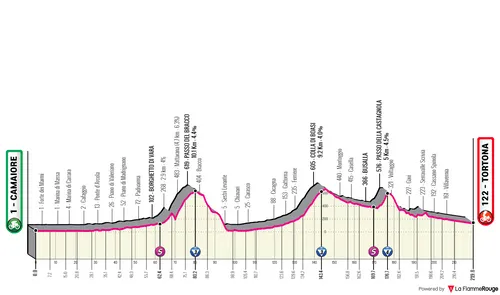
Stage 11 of the Giro d'Italia is to finish in the western city of Tortona. It is said to be a long day and one suited to the sprinters before the arrival to the Alps, although it does feature a couple of small ascents. It's another transition day, a long day on the bike with 219 kilometers on the menu, although these should be easier to control.
10.1 kilometers at 4.4%, 9.2 kilometers at 4% and 5 kilometers at 4.5% are the three ascents, and they end with 139, 76 and 43 kilometers to go. They aren't too hard, although they can be used to put pressure on some sprinters. From there on it's a slight downhill drag into Tortona.
Unlike some of the previous ones however, this sprint is more technical. It will be fast, the entrance to the final 2 kilometers sees a corner and roundabout that will be crucial. Here the peloton will thin out, and teams will make sure they get themselves in prime position here. Then there is another race to the final 500 meters where there is a sharp right-hand corner that leads into the final straight. It's all clear into the finish line from there on.
Read also
Stage 12: Bra - Rivoli, 179.4 kilometers.
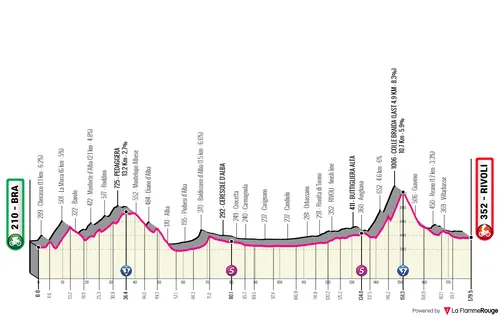
The 2022 Giro d'Italia saw an explosive and incredibly exciting stage into Torino, and a similar hilly day could be expected into Rivoli on the 12th stage which will feature some climbing, and a flat finale after a technical descent. Could this be a rest day for the GC riders ahead of a key day however? Most will have that in mind, others the stage win, and the breakaway stands very good chances.
There will be three different climbs within the first 36 kilometers. It's a whole hour of racing, the peloton will need to let the breakaway go at some point. The tough climb later in the day will put off most sprinters from wanting to work, whilst the hard following day and distance to the finish will put off the climbers. A lot of the middle section of the day is flat without much to mention. The action comes back at the Colle Braida.
It's a second category ascent, 10.7 kilometers at 5.8% that summits with 28 kilometers to go. A climb of two halves, with a small descent in the middle that lowers the average. The final 4.5 kilometers are decently hard averaging around 8%. This could be an attacked ascent, but into context most will look to keep things compact. However the descent will be quite technical so with no doubt the pace will be high towards the summit.
The riders then travel back to Rivoli. A big group sprint isn't expected, inside the city the riders find a few corners before the finish line, but there isn't any key moment that could be pointed out. It'll be a simple finish for a transition day.
Read also
Stage 13: Borgofranco d'Ivrea - Crans-Montana, 208.1 kilometers.
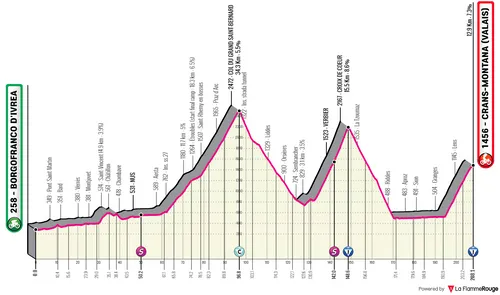
The Giro d'Italia will head into Switzerland in the 13th stage for a high-mountain finale at Crans-Montana. This is perhaps the toughest day of the race. Maybe it can be contested with stages 16 and 19, however this being the first of the three gruesome mountainous days it will be key for the overall classification, and surely expose weaknesses within some of the GC riders.
The first 60 kilometers of the stage are mostly flat, but what follows is an absolute monstrosity. There are about 5000 meters of climbing in 140 kilometers, beginning with the Cima Coppi the Col du Grand San Bernard. At 2473 meters of altitude this is the longest uninterrupted climb of the race and perhaps the whole World Tour calendar. It's a feared ascent, not for it's gradients, but the length and altitude.
34.3 kilometers in distance, 5.5% average gradient. The last 18 kilometers average 6.3% and its toughest kilometers come towards the finish. The climb goes up to immense altitude where the weather can change too, but this is an effort of well over an hour. It shouldn't see big moves just because of the equally brutal climb that follows but it will be felt by every rider later on.
The riders move onto the Croix de Couer. In my book this is the toughest climb of the whole Giro. It's 15.5 kilometers at 8.6% and summits with 60 kilometers to go. Again it's perhaps too far from the finish - which is also atop a big climb - for anyone to go all-in, but regardless of the pace there won't be many riders surviving in the peloton or breakaway respectively.
This is an insanely hard climb. Most will know it as the ascent to Verbier where Alberto Contador has in the past put in a much-discussed performance, however here the riders reach the village and keep climbing. Many switchbacks until that point, but then it rises into the Alpine. The final 6 kilometers average almost 10% and it's summit lies at almost 2200 meters of altitude.
The descent is equally technical, just as steep but even longer. The riders lose a whole 1700 meters in altitude, a mental difference. Through the Rhône valley then the run-up to the final ascent is pan-flat. There won't be much fight for positioning as the race should be split to bits at this point, and the climb is long and very constant.
The 13.1 kilometers into Crans-Montana don't see many gradient variations, with a steady 7% present most of the climb. However in total the climb has 15 switchbacks and most of them are in the first half. This could be called an explosive climb but at this point of the stage it's a test for survival. Gaps will easily be made and I would say early in the climb.
Read also
Stage 14: Sierre - Cassano Magnano, 194.6 kilometers.

The 14th stage of the Giro d'Italia will transition out of the Alps momentarily, for a very unusual day. Early in the stage the riders will ride up the Simplonpass, descend it and then have an almost completely flat finale into Cassano Magnano. It's a very unusual profile however that could make for very interesting racing. It's the Giro and the organizers know how to make special stages.
A flat start to the stage, and a 1.6-kilometer hilltop at 7.6% after 22 kilometers. That will be a warm-up for the main climb of the day however. The Simplonpass summits with 138 kilometers to go. It's a long way to the finish but... It's a whole 20 kilometers at 6.6% that have it's summit at 2000 meters of altitude. The sprinters have to deal with this climb if they want to fight for the win. The pace also can't be too easy, otherwise the riders that will inevitably attack may gain an unreachable gap.
The riders come down and then face a flat final 100 kilometers. There will be the need to control the breakaway, but roads flat and non-technical, ideal terrain to put in a strong organized chase. In the final 20 kilometers there will be a couple of hilltops however it's not something that would disrupt a possible bunch sprint.
As for the expected sprint it won't be easy either. There will be one final tight corner with 2.7 kilometers to go, from there on at the entrance of the final kilometers the riders take a right-hander but they won't need brakes. The finale sees gradients of up to 4%, it's not a regular sprint, but the fast men shouldn't be contested however.
Read also
Stage 15: Seregno - Bergamo, 196.9 kilometers.

The route of the 15th stage of the Giro d'Italia goes through some of the road of Il Lombardia. The climbs of Valico di Valcava, Selvino and Valpiana will be important on the day, and will make the selections for the win. The will also Colle Aperto, a short hilltop to be ridden before the finish in the scenic city where the decisive attack can be made. It's a day in Lombardia with 4000 meters of climbing to end the second week.
The start of the day features a few small ascents before reaching the Valico di Valcava. This is a climb known for it's presence at Il Lombardia. It's early in the day to cause much difference, but a breakaway can succeed in the day and here there is a clear selection point where those who can't fight for the win will be exposed, it's a very tough climb.
Two climbs will follow to put in more damage. Selvino (11.3Km; 5.5%; 98Km to go) and Miragolo San Salvatore (5.2Km; 6.9%; 85Km to go). The riders pass through the finish with 55 kilometers to go, riding for the first time the final cobbled hilltop. It will be a recon, but the decision of the stage will only be made later.
The most important ascent should certainy be Roncola Alta. It's 10 kilometers at 6.7% and summits with 31 kilometers to go. It features gradients up to 10% in it's middle and is where the climbers will look to make the difference. In the peloton I expect some conservative racing, but the climb (and day) is hard enough to try something.
The descent will be quite technical however and leave the riders with around 15 kilometers of racing. It's a dangerous day when it comes to the possibility of tactical moves. The riders head towards Bergamo for the finale of the stage, passing through the old town beforehand. That is where the riders find the hilltop, it's only 1.3 kilometers at 7.3%, but do feature some cobblestones and a 15% ramp. It's summit comes with only 3.4 kilometers to go, it's all downhill into the finish.
Read also
Stage 16: Sabbio Chiese - Monte Bondone, 200.5 kilometers.
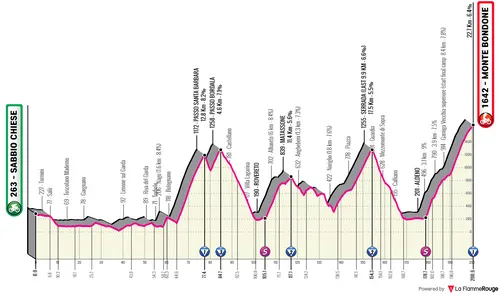
The final week of the Giro d'Italia begins with what will be another high mountain stage and summit finish. This will be another decisive day at the Giro d'Italia. It will be one of the hardest days of the race, and the finish at Monte Bondone on the outskirts of Trento will be another one where serious differences can be done.
The first 57 kilometers will mostly be flat. It isn't the first day where the start should be very friendly, and then an absurd amount of climbing follows in a short distance. Almost 5000 meters of climbing will be ridden in 140 kilometers. A small hilltop opens things up, but the first serious ascent is the Passo Santa Barbara.
This climb is 12.8 kilometers at 8.2%, a whole Alpe d'Huez essentially, but only the first of five climbs. This ends with 123 kilometers to go, and the Passo Bordala quickly follows with 4.6 kilometers at 7%. An incredibly technical descent follows but the race should calm down afterwards.
The peloton rides up the climb to Matassone, which is hard, but in context it is relatively gentle. It summits with 83 kilometers to go and features 11.4 kilometers at 5.6%, but does feature a flat section which lowers the average, it is generally quite steeper. A descent with a few sharp hilltops follow before the ascent to Serrada. This ascent is 17.5 kilometers at 5.5%. It ends with 46 kilometers to go, it's a long climb with 17.5 kilometers at over 5% but it'll be a warm-up for the finale. This is a tough climb where preparations will be made towards the final hour of racing.
That final hour of racing will be fully within the Monte Bondone. It's 22.7 kilometers in total at 6.4%, split into a few different sections. The first 3 kilometers average 9%, and then the climb gets a bit more gentle. Most likely the riders will wait for the final 8 kilometers which average 8%. The final couple kilometers are a bit more gentle, but throughout several kilometers the grade is at a steady 9%. It's a brutal climb, a day for the diesel engines and a climb just for that. Don't expect sharp attacks, but expect big gaps.
Read also
Stage 17: Pergine Valsugana - Caorle, 197.5 kilometers.
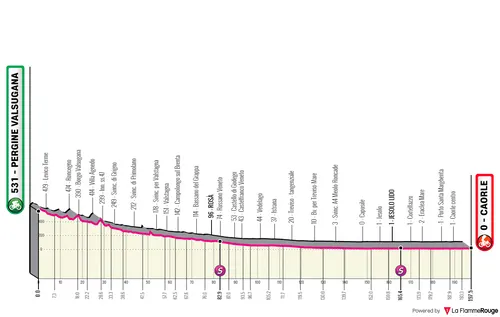
The Giro d'Italia has worked through it's formula, and this will be the traditional flat stage for the sprinters inside the third week, where breakaways could succeed aswell. It's a day as easy as it comes with only 500 meters of climbing, a start 500 meters below the finish altitude which is exactly at sea level.
The stage could be exposed to strong winds, that is a possibility, but if not it's a calm day on the bike until the final kilometers. The riders head into Veneto and then ride by the Mediterranean until reaching the town of Caorle where the finish will be.
This is a technical finale. Although at this point in the race the leadouts will be depleted, it's an easy day on the bike and everyone should be fresh into the finale. The speeds will be high and so will tension. With 2.1 and 1.9 kilometers to go there are sharp corner which stretch things out. Another one follows with 1.3 and then with 550 meters to go there is another difficult one that will thin the peloton towards the finish line.
Read also
Stage 18: Oderzo - Zoldo Alto, 160.2 kilometers.
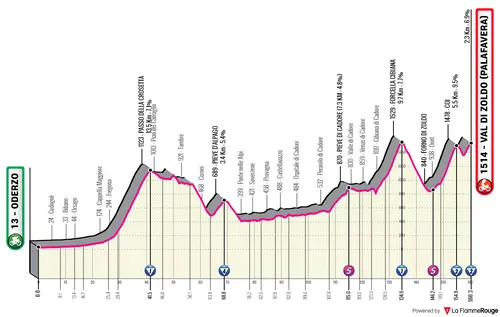
A tough mountain day. The final week of the race is brutal and there will be four difficult ascents on the day where differences can be created. This is the first of third gruesome racing days, however it may still be hard enough to influence the big riders to make moves and create differences for the overall classification.
The start is pan-flat, but after 25 kilometers of racing this quickly changes. It is a tough reminder of which race the riders are taking part in, the first challenge of the day is the Passo della Crosetta which is 13.5 kilometers at 7%. A tough one with no real descent immediately afterwards. However the riders will then be able to relax a bit before the decisive hour of racing.
The stage isn't long and the finale will be tightly packed with tough climbing. The Forcella Cibiana will be 9.7 kilometers long at 7.7% however the ascent reaches quite steeper gradients. This comes to an end with only 26 kilometers to go, however it's not where the GC riders should put in their efforts.
The climb to Coi is brutal and the main one of the day. It's 5.5 kilometers long at 9.5% and features tough ramps of up to 15%. It's a climb similar to Civiglio where Il Lombardia is usually decided, a suffocating steep climb filled with switchbacks. Even in a conservative pace this climb will make terrible damage in the GC group, and will in whichever scenario surely decide the outcome of the stage.
It's summit comes with a mere 5.4 kilometers to the finish. There is a very short and fast descent right after before the rise to the line. The final ascent is 2.3 kilometers have a 7% average gradient, it has 8 hairpins but it's not expected that at this point the riders are capable of putting on explosive moves.
Read also
Stage 19: Longarone - Tre Cime di Lavaredo, 183.2 kilometers.
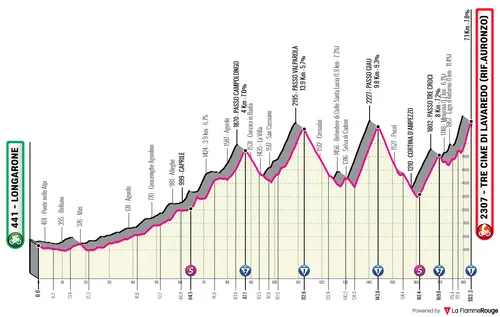
The queen stage? Stage 19 of the Giro d'Italia will head deep into the Dolomites, for a day that has in the past seen weather affect - most noticeably in 2013. This is the return of Tre Cime di Lavaredo to the Giro d'Italia. 5400 meters of climbing, high altitude, multiple climbs, both long and steep. It's the stuff nightmares are made of for the sprinters.
Another flat start but that means little on this day. There's nothing the peloton can do to avoid the Dolomite monster. A set of iconic passes will be ridden, starting with the Passo Campolongo (4Km; 7%; 95Km to go), it comes after a few small climbs which already take the riders to 1800 meters of altitude.
After a small descent comes the first big climb of the day which is the Passo Valparola. It's 13.9 kilometers at 5.7%, not a brutal ascent but it's summit is at almost 2200 meters of altitude. It features tough gradients towards the end, the riders will begin to feel it in the legs. It summits with 71 kilometers to go.
Afterwards comes the Passo Giau. This is a brutal ascent, another one that goes up to over 2200 meters of altitude. It's a brutal 10-kilometer ascent at over 9%, constant with steep gradients and no restbite. The race has had plenty memorable moments on this pass, which in this stage ends with 40 kilometers to go.
The descent leads directly into Cortina d'Ampezzo and the next climb starts right away. Now the Passo Tre Croci which is 8 kilometers at 7.2%. It's a climb, like several others on the day, that could be attacked hard, but is unlikely because of the brutality of what still follows. It ends with just over 13 kilometers to go.
There's no descent following, essentially a plateau section which leads to a sharp ramp of 1 kilometer at 11.4% which features a ramp of 18%. But this is still all in anticipation of the official ascent to Tre Cime di Lavaredo, which sees the finish line at 2300 meters of altitude.
The climb is 3.7 kilometers at over 11%. This is, and I cannot stress it enough, a matter of survival. Here teammates matter almost nothing, all riders just have to put in the pace they can sustain to the finish and hope for the best. The fatigue (both from the race and the day), the brutal gradients and the altitude make it possible for massive breakdowns on this beautiful but horrific road up the mountain.
Read also
Stage 20 (ITT): Tarvisio - Monte Lussari, 18.6 kilometers.
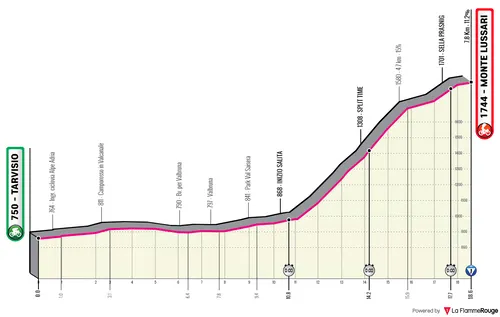
Stage 20 of the Giro d'Italia will be the final day for the overall classification contenders. It is likely to be within the distance of 11 kilometers with a flat first half, and a brutal second half. In total there are 18.6 kilometers, but don't be mistaken all riders will take it conservatively early on, and with a bike chance expected at the base of the final climb.
And the ascent is quite simply put: grizzly. It's brutal in every way. In total it is 7.6 kilometers at 11.3% but this is actually modest in comparison to the climb's true difficulty. It features it's first 4.7 kilometers at 15% average, just a constant grind at this insane gradient which will make for an horrific effort. Afterwards the grades do come down into what can be considered a normal climb.
However it is by no means easy, riders will already be at their limit at this point even with tiny chainrings, but there are still some very nasty ramps of over 15% in the closing three kilometers of the ascent. It's a very scenic finale but riders will need to pull off something special to get to the top.
Read also
Stage 21: Roma - Roma, 127.4 kilometers
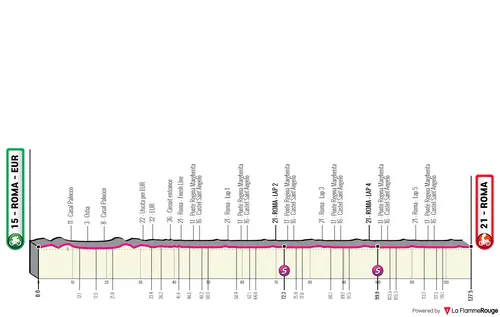
The finish was expected to finish in Trieste at the 2023 Giro d'Italia, but the plans of the race organizers had changed last-minute, and a flat day for the sprinters in Rome will conclude the race. It's an easy day on the bike and one everyone who's reached Rome deserves. It has truly been a brutal final week, and finally the riders see the end of the road, and the surviving sprinters have one final opportunity to fight for a win.
The riders ride just outside out-and-back into Rome and then enter the final circuit. The final circuit is 28 kilometers long and and is almost completely pan-flat. It's rather technical but the day should be calm and all will be saved for the final kilometers.
It's still a bit technical finale, but the sprinter teams will be burned out at this point and GC riders already in the back of the peloton. The riders pass through the Colosseum and enter the final straight with one kilometer to go. Then, racing away from the monument, they find the finish line in the city center.
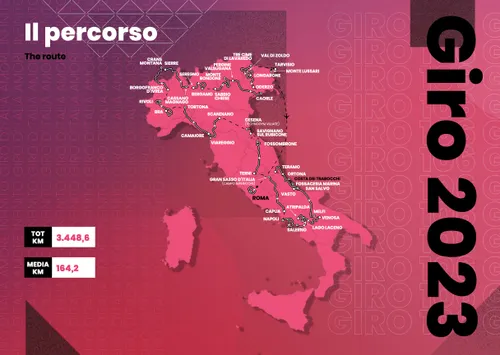
Official Map Giro d'Italia 2023
Estimated start and finish times for Giro d'Italia:
Stage 1: 13:50-17:10CET
Stage 2: 12:20-17:15CET
Stage 3: 11:45-17:15CET
Stage 4: 12:30-17:15CET
Stage 5: 12:40-17:15CET
Stage 6: 12:55-17:15CET
Stage 7: 11:15-17:15CET
Stage 8: 11:50-17:15CET
Stage 9: 13:10-17:10CET
Stage 10: 12:05-17:15CET
Stage 11: 11:25-17:15CET
Stage 12: 12:30-17:15CET
Stage 13: 11:00-17:15CET
Stage 14: 12:05-17:15CET
Stage 15: 11:45-17:15CET
Stage 16: 10:50-17:15CET
Stage 17: 12:50-17:15CET
Stage 18: 12:20-17:15CET
Stage 19: 11:35-17:15CET
Stage 20: 11:30-18:30CET
Stage 21: 15:25-18:45CET
claps 0visitors 0
Just in
Popular news
Latest comments
- The result at the TDF is independent of whether he rides Giro or not. 2nd at the TDFabstractengineer08-01-2026
- I wouldn't write them off for monuments any more than I would write off everyone competing against MVDP and Tadej. These two are the only clear favorites, but, if something happens Quick- Step has as good a chance as anyone.mij08-01-2026
- look at Remco and Egan. careers cut short if not permanently changed due to offseason crashes on the road. crashes happen, sadly, and being in competition does not make it any more or less likely.mij08-01-2026
- Makes sense. Finally got the Giro monkey off his back. Got a stage in all three GTs. He's never going to win the Tour, and probably isn't super fussed about fighting the young guns for leadership at other stage races. Why not just go out on a high?antipodeanpedalfan08-01-2026
- Everyone begins and ends life the same way. It's what we do in the middle that counts.paule08-01-2026
- Fact check false: I've crashed indoors before.acem8207-01-2026
- I'm wondering if he's quitting because Visma wouldn't make him their #1 at this year's Giro, which he believed suited him well. As defending champ he deserved his team's backing. After all, he's done a lot for Vingo.velodan07-01-2026
- If they keep sending Paul magnier to smaller races I expect he will bring in another heap of winsmobk07-01-2026
- Have a happy retirement, Simon. Not expecting this ...but well, you're leaving at the pinnacle of your careermhfrvz07-01-2026
- Talented, elegant rider. Enjoy your life, Simon! all the best.
 maria2024202407-01-2026
maria2024202407-01-2026
Loading
Take a deep breath. 🗺 Here is the Route of the Giro d’Italia 2023. . Fai un respiro profondo. 🗺 Ecco il Percorso del Giro d’Italia 2023. #Giro @ENIT_italia
Write a comment
